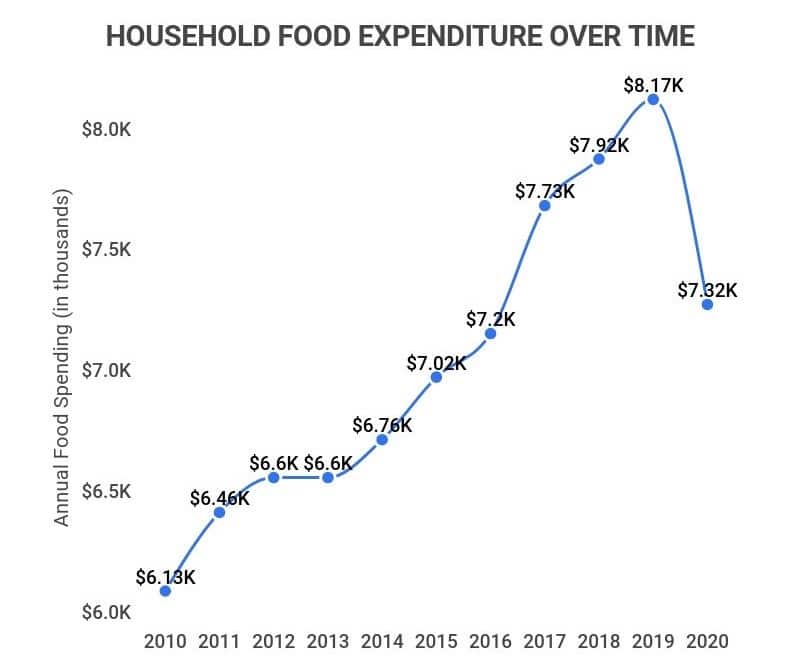- Industry Statistics
- Wedding Industry Statistics
- Yoga Industry Statistics
- Music Industry Statistics
- Landscaping Industry Statistics
- Bicycle Industry Statistics
- Coffee Industry Statistics
- Car Rental Industry Statistics
- Home Improvement Industry Statistics
- Insurance Industry Statistics
- Supplements Industry Statistics
- Golf Industry Statistics
- Fitness Industry Statistics
- US Media And Entertainment Industry Statistics
- Firearm Industry Statistics
- Financial Services Industry Statistics
- Health And Wellness Industry Statistics
- Trucking Industry Statistics
- Wine Industry Statistics
- Pet Industry Statistics
- Mobile App Industry Statistics
- Digital Marketing Industry Statistics
- Hotel Industry Statistics
- Retail Statistics
- Robotics Industry Statistics
- Jewelry Industry Statistics
- Appointment Scheduling statistics
- Restaurant Industry Statistics
- Food Delivery Statistics
- Food Truck Industry
- Fashion Industry
- Real Estate Industry
- US Film Industry
- US Beverage Industry
- USu202fFast Food Restaurants
- US Construction Industry
- US Book Industry
- Cosmetics Industry
- US Food Retail Industry
- US Pharmaceutical Industry
- US Healthcare Industry
- Oil And Gas Industry Statistics
- Airline Industry
- Nursing Shortage Statistics
- Automobile Industry
- Nursing Home Statistics
Research Summary. From grocery stores to foodservice facilities, you likely rely on the food retail industry for your food constantly. Most of us have gone to Walmart, CVS, or our big-name grocery store. What kind of presence does the food industry truly have in the United States? After extensive research, our data analysis team concluded:
-
The annual sales for the food retail industry hit an estimated $865 billion in 2020.
-
There are 38,307 supermarkets in the United States.
-
Food retail industry sales have more than tripled since 1992, amounting to $6.2 trillion today.
-
The average American spends $54 dollars a week and $233 per month on groceries.
For further analysis, we broke down the data in the following ways:
Grocery Store | Grocery Store Shopping | Economy | Trends and Predictions

General Food Retail Industry Statistics
Given that the food industry made $865 billion in 2020 alone, it’s no surprise that supermarkets are an integral part of American lives. Weekly or monthly trips to the food retail locations are the norms. Here are the facts:
-
In 2020, the annual sales for the food retail industry hit an estimated $865 billion.
And 60% of that figure can be attributed to supermarkets, which account for a majority of the food retail industry’s success.
-
Walmart is the largest food retail industry in the U.S., accounting for 39% of total industry sales.
In 2020, Walmart made $341 billion in sales, which is a significant margin of the $865 billion total food retail sales in the U.S. Walmart also owns and operates 4,756 stores across the country.
-
Warehouse clubs generated over $500 billion dollars in 2020.
This includes brands like Costco, Sam’s Club, and BJs. As of 2020, 105 million people made annual payments for their Costco membership and 47 million to Sam’s Club. However, despite being the largest grocery store, only 11% of people have subscribed to Walmart+.
-
2020 saw one in three of all U.S. households shopping online.
Due to the pandemic, 40 million people have tried online shopping. 26% reported that 2020 was the first time they’d ever used online grocery services, and that number goes up to 93% for those over 60..
| Retailer | 2020 Sales Revenue (in Billions USD) |
|---|---|
| Walmart | 369 |
| Amazon | 220 |
| The Kroger Co. | 132 |
| Costco | 115 |
| Walgreens Boots Alliance | 107 |
| Target Corp. | 93 |
| CVS Health | 91 |
| Albertsons Cos. | 69 |
| Sam’s Club | 63 |
| Ahold Delhaize | 51 |

Grocery Store Statistics
With over 38,000 grocery stores and supermarkets in the United States, you likely see them regularly when you’re out and about. In fact, the average American stops at the grocery store 1.6 times per week. Here are some other insights our research uncovered:
-
The median size of a U.S. grocery store is 42,415 ft.
For perspective on how large this is, the average size of an American football field is 48,000 sq feet, meaning that the average grocery store is almost as large as a stadium.
-
California has the largest number of grocery stores, with 1,700 stores.
Followed by Florida with 1,600 stores and Texas with 1,200 stores. Perhaps this is unsurprising, given that these states all have the top three highest populations in the country.
-
Despite making $759.57 billion in sales, the average grocery store only makes $14 million in yearly revenue.
This means that the average net profit for grocery stores is only around 2%, which is a pretty low number. Despite that, the sheer prevalence of grocery shopping in the U.S. prevents stores from losing money.
-
As of 2020, the average grocery store carries 39,500 items.
And this is a 29% increase from 2019 when the average number of items was 28,112.
-
The average sale per customer transaction is only $38.41.
Despite this relatively small amount, the average supermarket makes $554,958 per week.
-
The average profit margin in U.S. grocery stores is only 2%
And this averages at only 2.2 cents per grocery item sold. For perspective, grocery stores recently made over $750 billion in sales, but the average grocery store only makes $14 million in yearly revenue.
-
The average American household spends $4,643 per year on groceries.
This amounts to roughly $387 per month. And, grocery shopping has increased since the start of the COVID-19 Pandemic, with online shopping alone increasing by 54%.
-
The average American shopper makes 1.6 grocery shops per week.
However, the most recent numbers are from 2019, so it’s unclear how much online grocery shopping has impacted this statistic. Also, another interesting fact is that the average number of grocery shops per week has actually decreased, as the number 1.9 and 2.1 trips before 2010.
-
The global food retail industry is worth $11.7 trillion.
And this figure is expected to grow in years to come. From 2020-2027, experts predict a compound annual growth rate (CAGR) of 5.0%.
-
In the United States, the food grocery stores alone make up 15.6% of the total retail industry sales.
In 2020, grocery stores generated $759.57 billion in sales, while the overall retail industry made $4.85 trillion. While this might seem like a big disparity, 15.6% of the sales in an industry that includes most stores around the company is considerable.
-
Compared to other countries, the United States has a 46% share of the 250 largest global company’s revenues.
And 31.6% of the largest companies come from the United States. 79 of the top 250 companies come from the U.S., with the second-largest number of companies coming from Japan, with 31 of the 250 companies.
-
As of 2021, the U.S. food retail industry employs 2.89 million workers.
However, this work comes with high turnover and low job growth. The most common age for food retail employees is between 16-24, and many of these young employees leave their jobs to pursue other things.
-
The U.S. food retail industry experienced a 1.31% increase in sales growth each year from 2010-2019.
By comparison, the numbers from 2000-2009 were -0.19% on average per year. Further, this number is only expected to increase in the new decade.
-
Between 2020-2027, experts predict that the food retail industry will have a CAGR of 5.0%.
This is mostly attributed to big names like Walmart, Amazon, Dollar General, and more. Interestingly, the increase in CAGR is also dominated by the sale of packaged foods. In 2019, packaged foods made up about 40% share of the total revenue.
-
Online grocery sales grew by 54% in 2020.
Online grocery sales grew from $62.2 billion in 2019 to $95.8 billion in 2020. Now, online grocery sales account for 7.4% of all grocery sales and have a 12.0% share of total US e-commerce sales. And, this number is only growing, rising above $100 billion in 2021.
-
Since the start of the COVID-19 Pandemic, 49% of Americans report that they’re preparing more meals at home.
And this also goes hand in hand with getting take-out, as 58% of grocery shoppers also report that they’re eating at home more often in general.
-
Where is the food retail industry headed over the next decade?
Over the next decade, the food retail industry is expected to experience a steady 5% CAGR. However, there are several interesting trends present. Within 2020 alone, online grocery sales have risen by 54% and continued to grow steadily into 2021.
In fact, online sales now account for $112.9 billion, when it was only $62.2 billion in 2019. Additionally, it’s worth noting that a majority of the growth comes from industry leaders like Walmart and Amazon.
With that in mind, we can expect the food retail industry to experience continued growth within the next decade.
-
Should I take a job within the food retail industry?
While the question of whether or not you should take a job in the food retail industry is your choice, there are a few factors that might sway your decision. The industry employs 2.89 million workers, many of whom are young, part-time employees. These positions often lead to high turnover rates.
However, the need for these jobs as essential work during the COVID-19 Pandemic has seen an increase in compensation. For example, as of February 2021, Walmart announced its decision to raise its hourly minimum wage to at least $15 per hour.
-
How big is the U.S. food retail industry?
The U.S. food retail industry is huge, with sales reaching $6.2 billion and total revenue at $865 billion. Perhaps unsurprisingly, the industry that many Americans rely on for food access makes a lot of money, but what you might be surprised by is the fact that there are 38,307 supermarkets across the country.
In large states, that equates to thousands of grocery stores. California has 1,700, followed by Florida with 1,600, and Texas with 1,200. Overall, the U.S. food retail industry is huge and deeply intertwined with everyday American life.
-
What percentage of food retail are groceries?
Grocery store sales make up 92.1% of all food retail store sales. Combined, convenience stores and specialty stores only account for the remaining 7.9%, which is a drop in the bucket compared to grocery sales.
Online grocery sales are also starting to take off, growing 54% in 2020 alone. Currently, online grocery sales account for 13% of all U.S. grocery sales, and that number is expected to grow to at least 20% over the next five years.
-
Is the food retail industry growing?
Yes, the food retail industry is growing. The industry is expected to experience a steady 5% CAGR within the next decade, with big names like Walmart, Amazon, and Dollar General growing the most.
In fact, the food retail industry has seen somewhat of a turnaround from the early 2000s. From 2000 to 2009, the industry’s average per year increase in sales growth was -0.19%. However, between 2010 to 2019, it changed to a net positive 1.31%.
Overall, the retail food industry has been growing steadily since 2010, and trends like online grocery buying will cause continued growth for large retailers.
-
What is the largest food retailer in the U.S.?
Walmart is by far the largest food retailer in the U.S. With $341 billion in annual sales, Walmart alone accounts for 39% of total food retail industry sales. Believe it or not, Walmart also has 4,756 stores across the country.
For context, Walmart has far more sales and stores compared to the second-largest grocery competitors. For example, the second-largest company by sales is Amazon at $220 billion.
That’s over $100 billion less than Walmart. Further, the second-largest food retailer by the number of stores is The Kroger Co. at 3,225. That’s almost 1,500 less than Walmart.
-
What percentage of Americans use grocery delivery?
31% of Americans have used grocery delivery. That’s roughly 40 million people and represents a growing trend of online grocery ordering.
For instance, since the start of the COVID-19 pandemic, 26% reported that now is the first time they’ve ever used online grocery services. Even more telling, that number goes up to 93% for those over 60.
Overall, online grocery sales grew from $62.2 billion in 2019 to $95.8 billion in 2020. Now, online grocery sales account for 7.4% of all grocery sales and a 12.0% share of total US e-commerce sales. And this number is only growing, rising above $100 billion in 2021.
-
Statista. “U.S. food retail industry – statistics facts.” Accessed on August 25, 2021.
-
Statista. “Warehouse clubs in the United States – statistics facts.” Accessed on August 25, 2021.
-
FMI. “Median Total Store Size – Square Feet.” Accessed on August 25, 2021.
-
ScrapeHero. “The Largest Grocery Chains in the US – Location Analysis.” Accessed on August 25, 2021.
-
CHRON. “The Industry Standard for Gross Margin in Groceries.” Accessed on August 25, 2021.
-
FMI. “Supermarket Facts.” Accessed on August 25, 2021.
-
Grand View Research. “Global Food Grocery Retail Market Size Report, 2020-2027.” Accessed on August 26, 2021.
-
Deloitte. “Global Powers of Retailing 2019.” Accessed on August 26, 2021.
-
USDA. “Retail Trends.” Accessed on August 26, 2021.
-
Insider Intelligence. “In 2021, online grocery sales will surpass $100 billion.” Accessed on August 26, 2021.
-
Winsight Grocery Business. “3 Big Trends From FMI’s 2021 Grocery Shopper Report.” Accessed on August 26, 2021.
-
Nerdwallet. “How Much Should I Spend on Groceries?” Accessed on August 26, 2021.
-
Statista. “Consumers’ weekly grocery shopping trips in the United States from 2006 to 2019.” Accessed on August 25, 2021.
Number of U.S. Store Locations by Food Retailer
| Chain | 2021 Number of U.S. Stores |
|---|---|
| Walmart | 4,668 |
| The Kroger Co. | 3,225 |
| Publix | 1,326 |
| Food Lion | 1,104 |
| Save A Lot | 917 |
| Safeway Inc. | 899 |
| IGA | 780 |
| Southeastern Grocers | 578 |
| Shiloh Farms | 578 |
| Trader Joes | 548 |
Grocery Store Shopping Statistics
Going further into the world of grocery stores, here are some interesting statistics about grocery store shopping:
Food Retail Industry and the Economy Statistics
Being such a large industry, it’s no surprise that food retail has a profound effect on the U.S. economy. According to our research:
Food Retail Industry Trends and Predictions
So far, we’ve seen how vast and relevant the U.S. food retail industry currently is, but where might it be headed? Here’s what we found:
US Food Retail Industry Statistics FAQ
Conclusion
The United States food retail industry is a powerhouse of an industry that most Americans rely on. In fact, the average American makes 1.6 stops to the grocery store each week and spends $54 per week there. This reliance makes it easy to see why the industry is expected to have a CAGR of 5% from 2020-2027.
However, it’s also clear that the food retail industry is evolving. Online grocery shopping increased by 54% in 2020, and one in three of all households began shopping online. This trend toward online shopping is only expected to grow going forward.
Overall, food retail industry giants like Walmart will continue to thrive and adapt in the years to come.
References
- Industry Statistics
- Wedding Industry Statistics
- Yoga Industry Statistics
- Music Industry Statistics
- Landscaping Industry Statistics
- Bicycle Industry Statistics
- Coffee Industry Statistics
- Car Rental Industry Statistics
- Home Improvement Industry Statistics
- Insurance Industry Statistics
- Supplements Industry Statistics
- Golf Industry Statistics
- Fitness Industry Statistics
- US Media And Entertainment Industry Statistics
- Firearm Industry Statistics
- Financial Services Industry Statistics
- Health And Wellness Industry Statistics
- Trucking Industry Statistics
- Wine Industry Statistics
- Pet Industry Statistics
- Mobile App Industry Statistics
- Digital Marketing Industry Statistics
- Hotel Industry Statistics
- Retail Statistics
- Robotics Industry Statistics
- Jewelry Industry Statistics
- Appointment Scheduling statistics
- Restaurant Industry Statistics
- Food Delivery Statistics
- Food Truck Industry
- Fashion Industry
- Real Estate Industry
- US Film Industry
- US Beverage Industry
- USu202fFast Food Restaurants
- US Construction Industry
- US Book Industry
- Cosmetics Industry
- US Food Retail Industry
- US Pharmaceutical Industry
- US Healthcare Industry
- Oil And Gas Industry Statistics
- Airline Industry
- Nursing Shortage Statistics
- Automobile Industry
- Nursing Home Statistics





